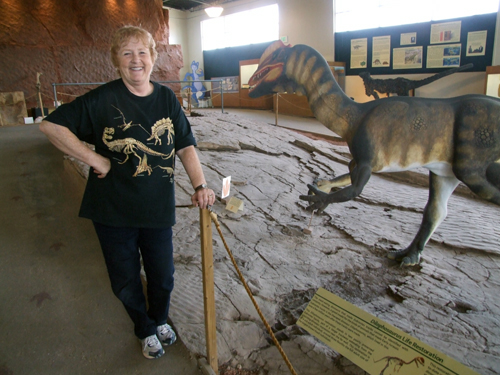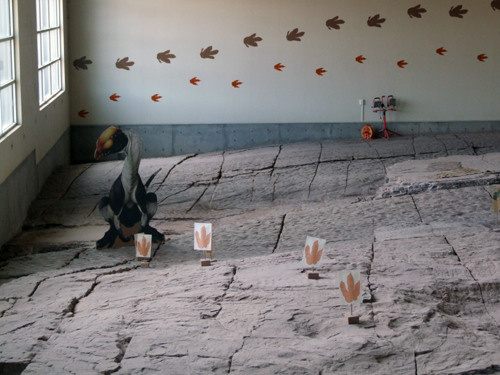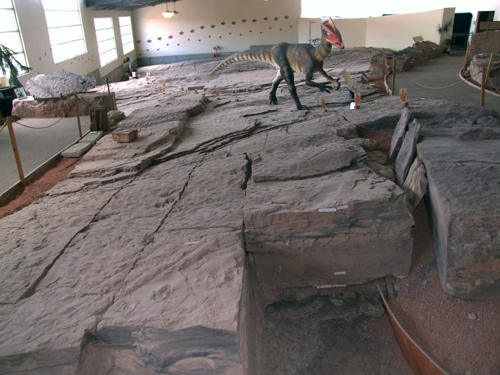
-Tenth in a Series-
By Donald H. Harrison

ST. GEORGE, Utah – You’ve heard about St. George and the dragon, but that’s a Christian legend from England which must be taken on faith. On the other hand, you have St. George and the dinosaurs and that’s a secular American tale for which there is plenty of tangible evidence!
The proof can be found at the Dinosaur Discovery Site at the Johnson Farm in this city in southern Utah, where some 2,000 dinosaur tracks are believed to be approximately 200 million years old.
The director of the Dinosaur Discovery Site, Rusty Salmon, explains to visitors that there was a lake here during the early Jurassic period where dinosaurs fed on prehistoric fish and plants. On the way to the life-sustaining body of water, the dinosaurs’ giant feet squished into the moist sandstone and formed impressions that quickly silted over.
The sandstone was of unusual composition, easily separating into layers which, once being covered over, preserved the footprints and even a haunch print. Other prints were made when the dinosaurs scratched the bottom of the lake while swimming in a manner similar to the way dogs paddle. Salmon said the Dinosaur Discovery site of St. George is one of the few places on earth where prints and fossil remains of dinosaurs all have been preserved together.

The discovery of this prehistoric treasure trove came in the year 2000 when Dr. Sheldon Johnson was scraping top layers of earth off the site preparatory to real estate development. Blocks of sandstone came up easily, but one of them tumbled from the claws of a bulldozer and flipped over in the process. Dr. Johnson saw a reverse impression of a dinosaur track and decided, along with his wife Laverne, to excavate the site, rather than to destroy it. Initially, the Johnsons operated the site, but eventually turned their property over to local government so it could be protected.
Salmon said people often ask her if it was difficult moving all the dinosaur tracks to the museum. In fact, it was the other way around; the museum was built over the site so that the dinosaur tracks could be left in situ allowing paleontologists from all over the world to access a site that provides clues into not only what kind of dinosaurs lived in prehistoric southern Utah and northwest Arizona but also what kind of routines they followed in their lives.

Dinosaurs have always been perplexing for people who read the Bible literally. If God created the world in six days 5,774 years ago, according to the Jewish calendar, then how can dinosaurs have existed 200 million years ago? Jewish religious scholars have answered in a number of ways. Some say that the Bible does not define how long those six “days” were – in fact, each ‘day” could have been hundreds of millions of years long, thus accommodating what scientists describe as evolutionary growth. Additionally, some religious scholars note that, according to Genesis 1:21, on the fifth “day,” God created the taninim, which may refers to “dinosaurs” though it is often translated as “crocodiles.” Kabbalists yet another answer: they say before God created the present world, He created and destroyed other “worlds” including that within which dinosaurs thrived.
While various streams of Jewish belief thus can accommodate dinosaurs, some people of fundamentalist religious backgrounds still don’t accept that the world is older than what a literal reading of the Bible says it is. Along one side of the museum are stations for paleontologists to study tiny fossils under microscopes. Salmon recalled one visitor watching a scientist at work in a glassed-in booth and then turning to his grandson and saying “See I told you they are making the fossils back there!”
Some of the tracks at the site have been identified as belonging to the eubrontes class, described in the video as those of a” three-toed dinosaur weighing approximately 1,000 pounds and stretching 18 feet in length and standing 7 feet tall at the hips.” Says Salmon: “Those prints there are probably the Dilophosaurus,” a species that got it’s Greek name from having two crests on its head.
Another track may have been made by the Coelophysis, a dinosaur that stood perhaps 9.8 feet tall on two legs, having short forearms used to help it hold its prey.
Many of the tracks are attributed to Megapnosaurus, which was about seven feet and four feet at the hips. What made it unusual for its day is that it typically traveled in packs, according to the museum video.
There are also tiny tracks at the site that were made by a crocodilian, a prehistoric animal that was the many-times-great granddaddy of modern day crocodiles and alligators, Salmon said.
While large portions of the museum are roped off, there are some specimens that children are allowed to touch. They have turned black from the oils in children’s hands, a good lesson in Salmon’s estimate because it teaches children why museums of various kinds are filled with “do not touch” signs.
It’s not surprising that a dinosaur weighing a ton might leave quite an impression in this primeval earth, but what draws paleontologists to the site, according to Salmon, is that “it isn’t just dinosaur prints; it is a whole lake eco-system. When we’re looking at fish we can see their swim trails, and bugs and, little worms. You can see where a horseshoe crab was dragged along. We have beautiful fine clay, real nice clay, mudstone, which is why we get such fine detail.”
Salmon previously was a director of a small general museum in Moab (a city in eastern Utah named for the biblical country that became Jordan), and when she moved to St. George in 2006 she began work as a volunteer guide, eventually becoming the paid director.
She said that she is a fan of movies and cartoons about dinosaurs whether they be The Flintstones or Steven Spielberg’s Jurassic Park. These popular treatments are replete with errors, she said, pointing out that humans and dinosaurs did not live at the same time as depicted in the Flintstones, and velociraptors were small creatures, not the large ones pictured by Spielberg in Jurassic Park. Regardless, said Salmon, these movies and cartoons generate interest in dinosaurs and give her material to talk about as she takes visitors around the museum site.
_____________________________________
IF YOU GO: We stopped in St. George along Interstate 15 en route from Las Vegas to Fillmore, Utah. In Fillmore, we stayed at the Best Western Paradise Inn. That motel has a restaurant called “The Garden of Eat’n.” Somehow biblical puns and dinosaurs all seemed to fit together, as did the name of the town of Fillmore, the former territorial capital of Utah. It was named after a man some considered a political “dinosaur,” the 13th U.S. President Millard Fillmore.
__________________________________________
*
Harrison is editor of San Diego Jewish World. He may be contacted via donald.harrison@sdjewishworld.com